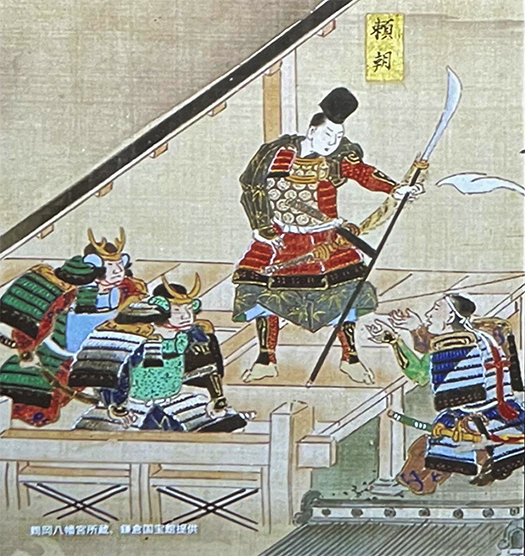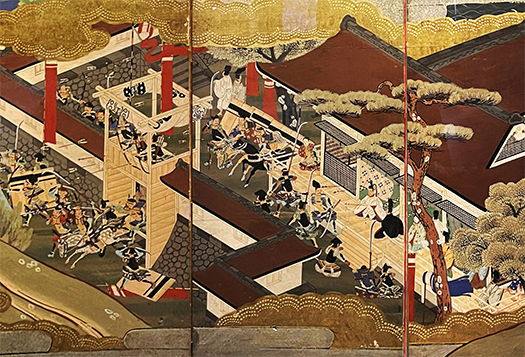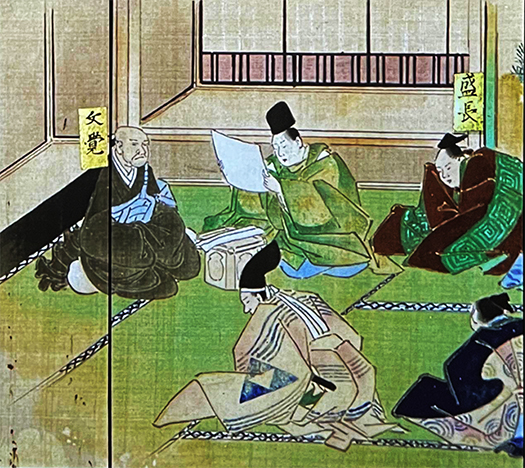


昨日に引き続いて日本社会独特の「メディア」屏風絵表現について。わたしという人間はずっとメディアという産業について強い興味を持って人生を過ごしてきた。現代社会、現代テクノロジーとしては写真というツールがもっとも「リアリズム」を体現した手法だと確信して生きてきました。
住宅写真はその時代のリアルな人々の暮らしを活写することは自分の体験として、もっとも真実性のあるメディア要素なのだと。人類は写真という現実を余すところなく伝える手段を得たことで、文化共有性を飛躍的に高めたのだろうと思います。その「事実報道性」に立脚して、その先に「どう生きるか,暮らすか」というテーマを考えて行く視点がしっかり定まっていく。
この写真より以前の社会。わたしたちの先人たちが作ってきた社会のことを伝えてくれるものとして、さまざまな画像表現があったのだと思う。画像なのでそこに「創作性」が色濃く存在した。けれども、わたしとしてはその創造者たちの心象に思いを致すことが多くなってくる。
上の画像群は歴史上のエポックメーキングな事件断面についてあきらかに「報道」の姿勢を持っている。後世の人間たちとしては、さまざまな表現の経緯を想像させられる。具体的な事件にあたって当事者はどのように対応したのか、その事実をどのように伝えたいと思って勧進元は表現者に依頼したのか、そして最終表現者は、その勧進元との相互関係に置いて、どこにいちばん留意して制作したか。
これらの主要な「探求姿勢」で具体的な画像作品と、じっくりと対話の時間を持つ。
わたしはこういう対話の全プロセスに強く惹かれるのですね。とくに報道性と芸術性の合間の部分への興味が最大のものだと思えるのですね。
結局,現代にまで残り続けたこれらの時代表現物の奥行きにゾッコンにさせられている。その多くは現代では博物館とか、美術館、歴史館などに集約されている。そしてそういう存在は、その地域のアイデンティティをわかりやすく伝えてくれている。当たり前だけれど、過去と現在を、同じ人間同士として時間を超えて共有体験の機会を与えてくれるのだと思う。
「おお、頼朝さんはこういう事件に際してこのように表現されたのか」「貴族から武家へと権力中枢が移動していく現場って、こういう実相だったのか」「この事件をこのように伝えたことが、当時の制作勧進元にとって有益だったのか」「報道絵画として、もっともわかりやすい画角としてこういうアングルを選択したのか」「この人物はこういう典型的人生を送ったのか」
武家の権力が出現した鎌倉での定点観測、その探究の心理動機でしょうか。
English version⬇
Press and Art: The Fascination of “Folding Screen Painting” History of Kamakura-5
In the age without photography, images were produced in the interval between the press and art. As a person who has continued the media, I am strongly attracted to the motive of the production process. …
Continuing from yesterday’s article, I would like to discuss the unique “media” byobu-e expression in Japanese society. I have spent my entire life with a strong interest in the media industry. I have always been convinced that photography is the tool that best embodies “realism” in contemporary society and technology.
I believe that residential photography is the most truthful media element for capturing the lives of real people of that era as they experienced it themselves. I believe that the fact that humankind has acquired the means to convey reality in its entirety through photography has dramatically increased our ability to share culture. Based on this “factual reportage,” the viewpoint from which to consider the theme of “how to live and how to live” is firmly established.
Society before this photograph. I believe that there were various forms of image expression that conveyed the society that our predecessors had created. Because they were images, there was a strong sense of “creativity” in them. However, I often think about the mental images of the creators of these images.
The above images are clearly “reporting” on a cross-section of epoch-making events in history. As future generations, we can imagine the various ways in which they were expressed. How did the parties involved respond to the specific incident, how did the kanjin-gen commission the artists to convey the facts, and what did the artists pay most attention to in their interrelationship with the kanjin-gen in creating their works?
These are the main “explorations” that I spend time discussing with the specific image works.
I am strongly attracted to this whole process of dialogue. In particular, you seem to have the greatest interest in the in-between of journalistic and artistic aspects.
In the end, I am fascinated by the depth of these time-honored, representative objects that have survived to the present day. Many of them are concentrated in museums, art galleries, and history halls today. These places convey the identity of the region in a way that is easy to understand. It is natural, but I think they give us an opportunity to share the past and the present as human beings beyond time.
The paintings are also very useful for us to understand how the incident was reported to the production promoters of the time. Was this angle chosen as the most obvious angle for a news painting?
These questions may be the psychological motive for the inquiry, a fixed point of observation in Kamakura, where the power of the warrior class emerged.
Posted on 4月 9th, 2023 by 三木 奎吾
Filed under: 未分類







コメントを投稿
「※誹謗中傷や、悪意のある書き込み、営利目的などのコメントを防ぐために、投稿された全てのコメントは一時的に保留されますのでご了承ください。」
You must be logged in to post a comment.